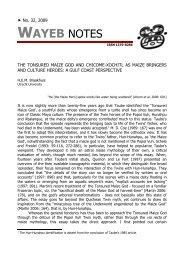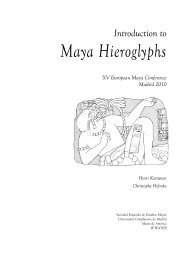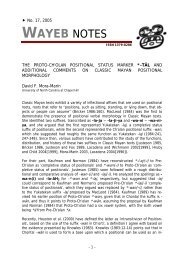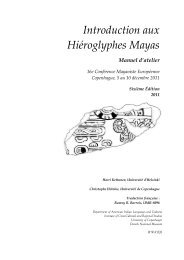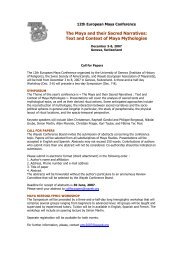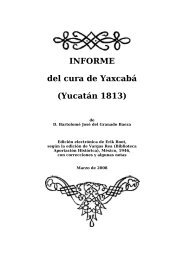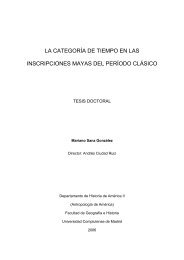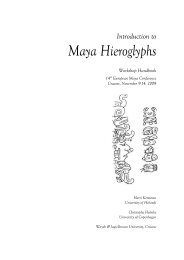Introduction to Maya Hieroglyphs - Wayeb
Introduction to Maya Hieroglyphs - Wayeb
Introduction to Maya Hieroglyphs - Wayeb
Create successful ePaper yourself
Turn your PDF publications into a flip-book with our unique Google optimized e-Paper software.
Kettunen & Helmke 2011<br />
Appendices<br />
INTRANSITIVE VERBS<br />
Intransitive verbs are verbs that do not have a direct object, i.e., verbs that do not need an object or verbs that<br />
cannot have an object are intransitive verbs. In Classic <strong>Maya</strong> intransitive verbs are derived either from a verbal<br />
root or from a noun.<br />
ROOT INTRANSITIVES:<br />
CVC-i-ABS<br />
hu-li u-ti<br />
huli<br />
u[h]ti<br />
hul-i-Ø<br />
u[h]t-i-Ø<br />
“he/she arrived”<br />
“it happened”<br />
DERIVED INTRANSITIVES: NOUN/ADJ-Vj (-aj/-iij)-ABS<br />
AK’-ta-ja K’AL HUN-na-ja<br />
a[h]k’taj<br />
k’al hunaj / huunaj / hu’naj<br />
a[h]k’t-aj-Ø<br />
k’al hun/huun/hu’n-aj-Ø<br />
“he/she danced”<br />
< ahk’ot (“dance”) with /o/ syncopated<br />
“he/she was crowned”<br />
< k’al hun/huun/hu’n? (“crowning”)<br />
pi-tzi-ja WITZ-ja/ wi-tzi-ja<br />
pitziij / pitzaj<br />
witziij /witzaj<br />
pitz-iij-Ø / pitz-aj-Ø<br />
witz-iij-Ø / witz-aj-Ø<br />
“he/she played ball”<br />
< pitz (“ballgame”)<br />
“it got piled up ”<br />
< witz (“mountain”)<br />
POSITIONALS<br />
CVC-l-aj-ABS (Eastern Ch’olan)<br />
CVC-waan?-ABS (Western Ch’olan)<br />
Positional verbs refer <strong>to</strong> physical states or positions, such as standing, sitting, kneeling, hanging, lying down,<br />
leaning, bending, and bowing, that human beings, animals, and inanimate objects can assume (Bricker 1986: 29;<br />
Lacadena and Wichmann 2002b).<br />
CHUM[mu]-la-ja CHUM[mu]-wa-ni<br />
chumlaj<br />
chumwaan<br />
chum-l-aj-Ø<br />
chum-waan-Ø<br />
“he/she sat”<br />
“he/she sat”<br />
Along with positionals, there is a class of verbs can be derived from positionals: the –bu causative. E.g. pat-laj “got<br />
made” > u-pat-bu “he/she made it” > u-pat-bu-uj “he/she has made it”.<br />
69/154



